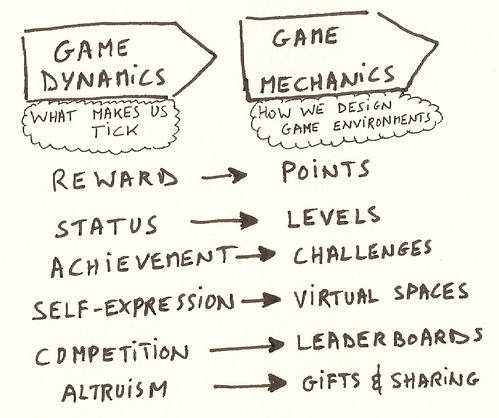Gamification is not about playing games at work. It’s about solving real-life problems. If you want to do it right, it pays to investigate the building blocks. They are: the dynamics, the mechanics and the process that ties them together over time.
Building further on the insights of gamification guru Gabe Zichermann, let’s dive a little deeper into the definition and its components. Last spring I had the opportunity to interview him on the Techguru conference in Brussels. In an amazing 40 seconds he unveils the essence of gamification.
The Definition
In fact, there are different definitions for gamification, depending on who you talk to.
The use of game mechanics/dynamics to drive game-like engagement and actions in non-game environments (e.g. work, education, exercise, etc.)
– Michael WuInventing new work and business practices that engage employees, customers and consumers as effectively as a good game.
– Jane McGonigal
The process of using game thinking and game mechanics to solve problems and engage users.
– Gabe Zichermann
While all of these definitions demonstrate that it is about the use of game mechanics, I prefer to show all three of them because they use a slightly different emphasis. More precisely:
- That it’s about non-game environments (Wu)
- That it’s about engagement (McGonigal)
- That it’s about problem-solving (Zichermann)
Dynamics + Mechanics = A Process
As Zichermann pointed out in the above video it is essential to make a distinction between:
- Game dynamics: how we choose to think about the world, the way we solve problems, and how we interact with other people;
- Game mechanics: the tools we use to play games, such as points, levels, badges, leaderboards, challenges and rewards.
The art of finding the right mechanics to respond to the dynamics of a specific situation and creating a process over time is gamification. The below drawing shows some examples of how some mechanics respond best to some dynamics at hand (drawing based on this presentation of Michael Wu).
Game dynamics and mechanics are proving to be critical for the next generation of social networks. We will be witnessing a similar wave heading towards organizations with a delay of … well … ummmm … depends on how late your organization already is today in unlocking the potential of social media. As a rule of thumb: apply the same delay and the same change-pains caused by being a laggard.




